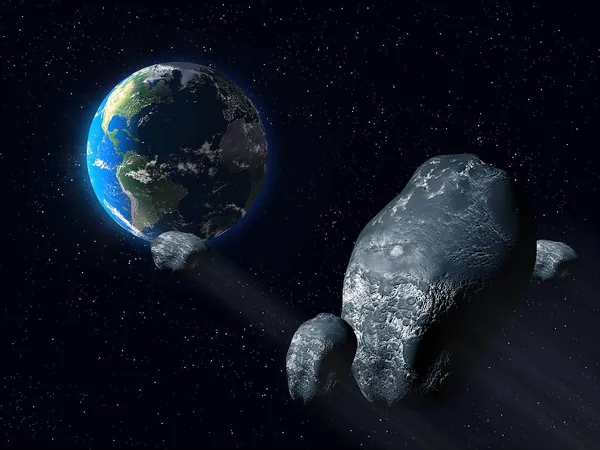
Asteroid 2024 YR: A Close Call but Not the Last Word on Earth Impact
2025-03-24
Author: Arjun
In late 2024, astronomers made a keen observation of asteroid 2024 YR4, initially flagged for being on a trajectory that posed a potential threat to Earth. This discovery triggered intense scrutiny, revealing that while this "city-killer," estimated to range between 40 to 90 meters in diameter, will not collide with our planet in the near future, we cannot completely dismiss the possibility of an impact on the Moon.
However, that’s just the tip of the asteroid iceberg. Earlier this year, a significantly larger asteroid—887 Alinda—passed through the cosmic neighborhood with little fanfare. With a diameter of over four kilometers, Alinda is a much more formidable player, capable of instigating a global extinction event if it were to strike Earth.
The Dangerous Dance of Asteroids
Both 2024 YR4 and Alinda share a unique orbital relationship with Jupiter; they complete three orbits around the Sun for every single orbit of the gas giant, which takes approximately 12 years. This synchronization means these asteroids return to similar paths every four years, making them objects of concern for astronomers and planetary defense enthusiasts alike.
Discovered in 1918, Alinda has approached Earth several times at these four-year intervals. In contrast, 2024 YR4 has only recently garnered attention despite making close passes since 1948, raising questions about our ability to monitor the vastness of space effectively.
In the late 1800s, American astronomer Daniel Kirkwood first noted peculiar gaps in the belt of asteroids, which later came to be known as "Kirkwood gaps." These gaps are observed in graphs plotting asteroids' average distances from the Sun and were long viewed merely as curiosities of the solar system until new computer technologies in the 1970s unveiled their true significance.
Will They Be Back?
The alarming aspect of these Kirkwood gaps is that they signify potential collisions. Alinda-class asteroids, like 2024 YR4, have orbits that could align with Earth's every four years—a recipe for disaster. While not all such asteroids are on a direct collision course, the alarming reality is that both Alinda and 2024 YR4 lie almost in the same plane as Earth's orbit, making potential impacts a genuine concern.
Fortunately, 2024 YR4 is expected to miss Earth in 2032. However, this close encounter will alter its orbit, diluting its chances of returning with the same frequency. The computer simulations suggest another near-miss could occur in 2052, but accurate long-term predictions remain challenging.
A Sky Full of Risks
The threat from asteroids is far from theoretical. On February 15, 2013, a previously undetected asteroid exploded over Chelyabinsk, Russia, injuring over a thousand people due to the shockwave that shattered windows. Even more dramatically, the 1908 Tunguska event saw a gigantic explosion flatten vast swathes of forest in Siberia.
With Earth being a relatively small target in the cosmos, maintaining vigilance is vital. Current local and international monitoring efforts are critical, but they may be insufficient. According to Amy Mainzer, lead scientist on the upcoming Near-Earth Object (NEO) surveyor mission, "we only know about 40% of the asteroids that could cause significant regional damage." The NEO surveyor, scheduled for launch in late 2027, aims to change that by mapping and analyzing these potential threats efficiently.
Conclusion
As we strive to understand and monitor these celestial wanderers, it is crucial to focus on resonant asteroids like 2024 YR4 because their peculiar orbits ensure they will cross our path again. While we can breathe easy for now, vigilance must remain our motto as we continue our exploration of the universe and defend our home planet against the unknown.



 Brasil (PT)
Brasil (PT)
 Canada (EN)
Canada (EN)
 Chile (ES)
Chile (ES)
 Česko (CS)
Česko (CS)
 대한민국 (KO)
대한민국 (KO)
 España (ES)
España (ES)
 France (FR)
France (FR)
 Hong Kong (EN)
Hong Kong (EN)
 Italia (IT)
Italia (IT)
 日本 (JA)
日本 (JA)
 Magyarország (HU)
Magyarország (HU)
 Norge (NO)
Norge (NO)
 Polska (PL)
Polska (PL)
 Schweiz (DE)
Schweiz (DE)
 Singapore (EN)
Singapore (EN)
 Sverige (SV)
Sverige (SV)
 Suomi (FI)
Suomi (FI)
 Türkiye (TR)
Türkiye (TR)
 الإمارات العربية المتحدة (AR)
الإمارات العربية المتحدة (AR)